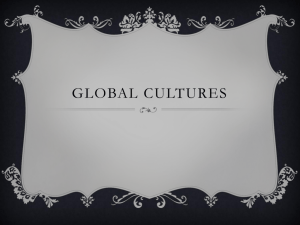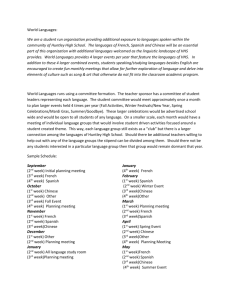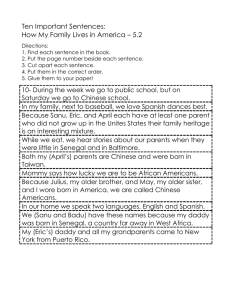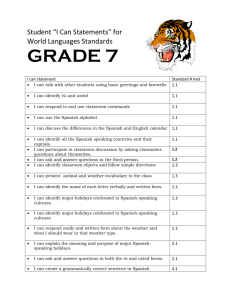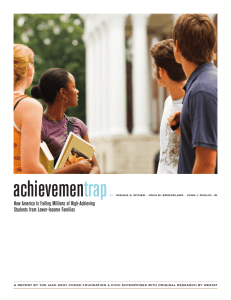Culture
advertisement
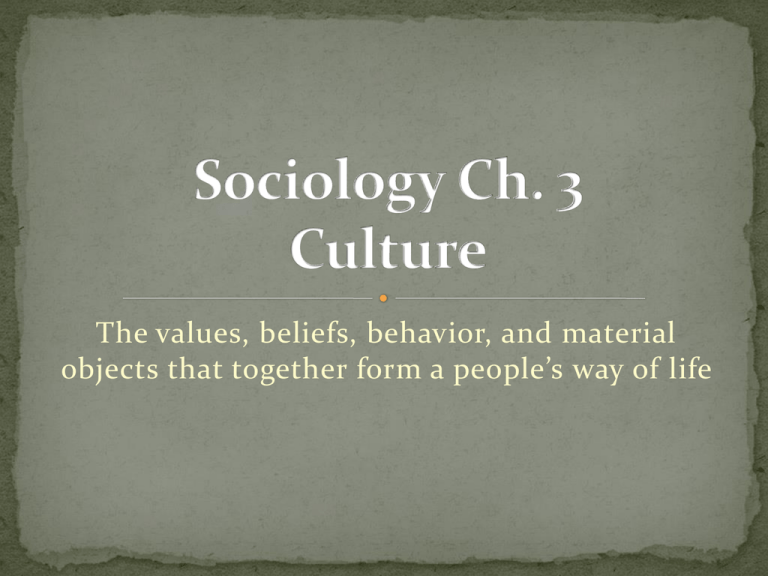
The values, beliefs, behavior, and material objects that together form a people’s way of life Nonmaterial culture The intangible world of ideas created by members of a society Material culture The tangible things created by members of a society Culture shock Disorientation due to the inability to make sense out of one’s surroundings Domestic and foreign travel Ethnocentrism A biased “cultural yardstick” Cultural relativism More accurate understanding Anything that carries a particular meaning recognized by people who share a culture Societies create new symbols all the time. Reality for humans is found in the meaning things carry with them. The basis of culture; makes life possible People must be mindful that meanings vary from culture to culture. Meanings can even vary greatly within the same groups of people. Fur coats, Confederate flags, etc. A system of symbols that allows people to communicate with one another Cultural transmission The process by which one generation passes culture to the next Sapir-Whorf thesis People perceive the world through the cultural lens of language Global Map 3.1 Language in Global Perspective Detail on next three slides Global Map 3.1aLanguage in Global Perspective–Chinese Chinese (including Mandarin, Cantonese, and dozens of other dialects) is the native tongue of one-fifth of the world’s people, almost all of whom live in Asia. Although all Chinese people read and write with the same characters, they use several dozen dialects. The “official” dialect, taught in schools throughout the People’s Republic of China and the Republic of Taiwan, is Mandarin (the dialect of Beijing, China’s historical capital city). Cantonese, the language of Canton, is the second most common Chinese dialect. Global Map 3.1b Language in Global Perspective–English English is the native tongue or official language in several world regions (spoken by one-tenth of humanity) and has become the preferred second language in most of the world. Global Map 3.1c Language in Global Perspective– Spanish The largest concentration of Spanish speakers is in Latin America and, or course, Spain. Spanish is also the second most widely spoken language in the United States Values Culturally defined standards of desirability, goodness, and beauty, which serve as broad guidelines for social living. Values support beliefs. Beliefs Specific statements that people hold to be true. Particular matters that individuals consider to be true or false. 1. 2. 3. 4. 5. 6. 7. 8. 9. 10. Equal opportunity Achievement and success Material comfort Activity and work Practicality and efficiency Progress Science Democracy and free enterprise Freedom Racism and group superiority Are some of these values inconsistent with one another? Williams's list includes examples of value clusters. Sometimes one key cultural value contradicts another. Value conflict causes strain. Values change over time. A Global Perspective Cultures have their own values. • Lower-income nations have cultures that value survival. • Higher-income countries have cultures that value individualism and self-expression. • Figure 3.2 Cultural Values of Selected Countries Higher-income countries are secular-rational and favor self-expression. The cultures of lower-income countries are more traditional and concerned with economic survival. Source: Modernization, Cultural Change and Democracy by Ronald Inglehart and Christian Weizel, New York: Cambridge University Press, 2005. Rules and expectations by which society guides its members’ behavior Types Proscriptive Should-nots, prohibited Prescriptive Shoulds, prescribed like medicine Mores and Folkways Mores (pronounced "more-rays") Widely observed and have great moral significance Folkways Norms for routine and causal interaction Various means by which members of society encourage conformity to norms Guilt A negative judgment we make about ourselves Shame The painful sense that others disapprove of our actions Ideal culture The way things should be Social patterns mandated by values and norms Real culture They way things actually occur in everyday life Social patterns that only approximate cultural expectations Culture includes a wide range of physical human creations or artifacts. A society's artifacts partly reflect underlying cultural values. In addition to reflecting values, material culture also reflects a society's technology or knowledge that people use to make a way of life in their surroundings. High culture–Cultural patterns that distinguish a society’s elite. Popular culture–Cultural patterns that are widespread among society’s population. Subculture–Cultural patterns set apart some segment of society’s population. Counterculture–Cultural patterns that strongly oppose those widely accepted within a society. An educational program recognizing the cultural diversity of the United States and promoting the equality of all cultural traditions. • Eurocentrism–The dominance of European (especially English) cultural patterns • Afrocentrism–The dominance of African cultural patterns National Map 3.1 Language Diversity across the United States (detail on next slide) Of more than 268 million people age five or older in the United States, the Census Bureau reports that 52 million (19%) speak a language other than English at home. Of these, 62% speak Spanish, and 15% use an Asian language (the Census Bureau lists 29 languages, each of which is favored by more than 100,000 people). The map shows that nonEnglish speakers are concentrated in certain regions of the country. Which ones? What accounts for this pattern? Source: U.S. Census Bureau (2003, 2006). Culture integration The close relationships among various elements of a cultural system Example: Computers and changes in our language Culture lag The fact that some cultural elements change more quickly than others, which might disrupt a cultural system Example: Medical procedures and ethics 1. Invention–Creating new cultural elements Telephone or airplane 2. Discovery–Recognizing and better understanding of something already in existence X-rays or DNA 3. Diffusion–The spread of cultural traits from one society to another Jazz music or much of the English language Figure 3.3 Life Objectives of First-Year College Students, 1969-2006 Researchers have surveyed first year college students every year since 1969. While attitudes about some things such as the importance of family have stayed about the same, attitudes about other life goals have changed dramatically. Sources: Astin et al. (2002) and Sax et al. (2006). Ethnocentrism The practice of judging another culture by the standards of one’s own culture Cultural relativism The practice of judging a culture by its own standards Figure 3.4 The View from “Down Under” North America should be “up” and South America “down,” or so we think. But because we live on a globe, “up” and “down” have no meaning at all. The reason this map of the Western Hemisphere looks wrong to us is not that it is geographically inaccurate; it simply violates our ethnocentric assumption that the United States should be “above” the rest of the Americas. The Basic Thesis The flow of goods–Material product trading has never been as important. The flow of information–Few, if any, places are left where worldwide communication isn’t possible. The flow of people–Knowledge means people learn about places where they feel life might be better. Limitations to the thesis All the flows have been uneven. Assumes affordability of goods People don’t attach the same meaning to material goods. Structural-functional Culture is a complex strategy for meeting human needs. Cultural universals–Traits that are part of every known culture; includes family, funeral rites, and jokes Critical evaluation Ignores cultural diversity and downplays importance of change Social-conflict Cultural traits benefit some members at the expense of others. Approach rooted in Karl Marx and materialism; society’s system of material production has a powerful effect on the rest of a culture. Critical evaluation Understates the ways cultural patterns integrate members into society Sociobiology A theoretical paradigm that explores ways in which human biology affects how we create culture. Approach rooted in Charles Darwin and evolution; living organisms change over long periods of time based on natural selection. Critical evaluation Might be used to support racism or sexism Little evidence to support theory; people learn behavior within a cultural system Culture as constraint We only know our world in terms of our culture. Culture as freedom Culture is changing and offers a variety of opportunities. Sociologists share the goal of learning more about cultural diversity. Applying Theory: Culture
